The papaya is a tropical fruit with a green outer covering and bright orange flesh on the interior. It has seeds and a mellow and sweet flavor, comparable to a melon. Most of us eat or have tasted papaya, and guinea pigs can as well.
The papaya is a delicious fruit that guinea pigs like. It’s an excellent source of vitamin C for them. However, I am cautious about how I offer it to the guinea pigs. Because of the high sugar level, I only feed them twice a week. I also take out the seeds because they are a choking hazard for them.
Table of Content
Is Papaya Good for Guinea Pigs? | Health Benefits
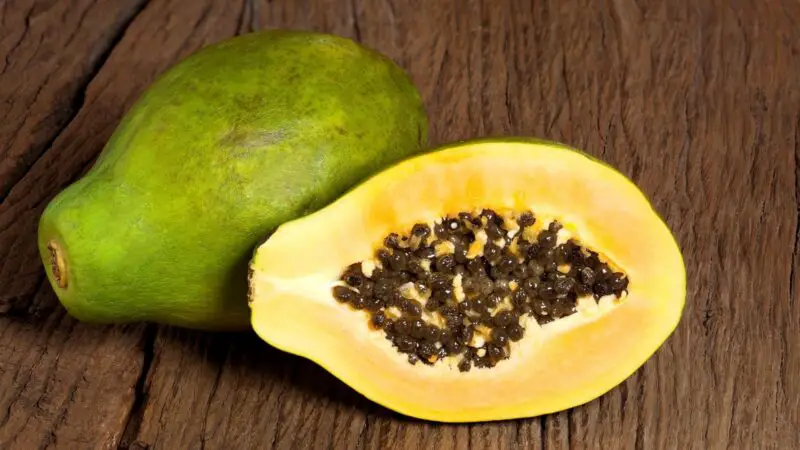
- Vitamin A in papaya will remove toxins and free radical damage. This means guinea pigs can only have fewer diseases and stronger immunity.
- The vitamin C in papaya will keep the guinea pig safe from scurvy, which is fatal. It starts with these symptoms: rough coat, no appetite, diarrhea, and bleeding.
- Papaya also has a lot of fiber. For the digestive tract to remain in balance, fiber is crucial. As a result, including a little papaya in your guinea pig’s food can help with digestion.
Nutrition Facts of Papaya
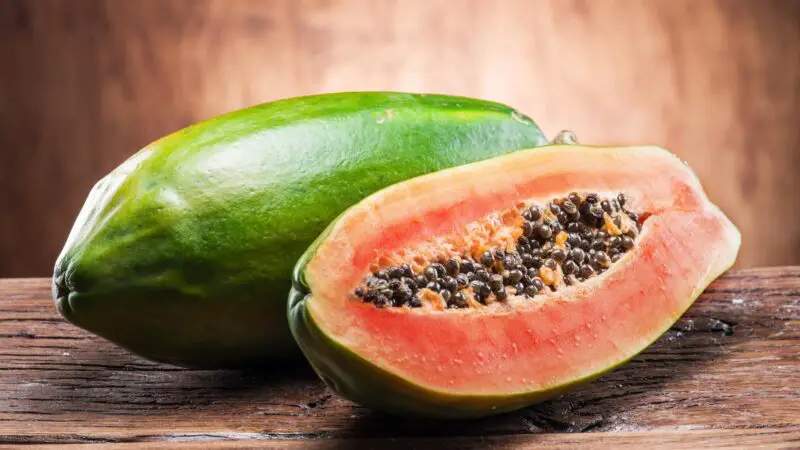
The nutritional information for 100 g (3 oz) papaya:
- A normal amount of calories – 39 calories. This fruit is not too fattening if served in a moderate amount.
- Carbs and protein – 9.8 g of carbs and 0.6 g of protein. The carb content is quite high, so there is a small risk of weight changes if you feed the guinea pig who consumes too much papaya.
- Fiber – 1.8 g. The papaya also has a good amount of fiber. A lack of fibers will make the guinea pig constipated, and excess fibers will cause gas or loose stool.
- Sugars – 5.9 g. The amount of sugar in papaya is too high. They cannot digest sugars very well, and if they have excess sugars in the stomach, they will get cramps or digestion problems.
- Low in fat – 0.1 g. Less fat means a healthier cardiovascular system.
- Vitamin A – 22%. This vitamin works as an antioxidant and removes free radicals. The lungs, kidneys, skin, heart, and eyes will be in good health, and the immunity will be boosted as well.
- Vitamin C – 103%. Vitamin C is crucial for survival in guinea pigs. Guinea pigs don’t produce this vitamin naturally, so they must get it from food and supplements. Without it, they are prone to a fatal disease called scurvy.
- Vitamin E – 4%. This vitamin is mainly beneficial for healthy skin and eyesight too. Additionally, it prevents inflammations and irritations of the skin.
- Thiamin – 2%. Also known as vitamin B1, it keeps the heart, muscles, brain, intestines, and stomach healthy. It promotes good oxygen through the cells too.
- Vitamin B6 – 1%. This vitamin prevents anemia, but most importantly it reduces anxiety, boosts serotonin (happiness hormone), and helps sleep disorders.
- Calcium – 2%. A mineral vital for the formation of strong bones, but it is not so needed once the guinea pig grows up. Then, it can even be damaging for them and cause urinary problems.
- Iron – 1%. Iron prevents anemia.
- Potassium – 7%. This nutrient balances blood pressure and keeps the cardiovascular system healthy.
Can Papaya Be Bad for Guinea Pigs? | Possible Risks
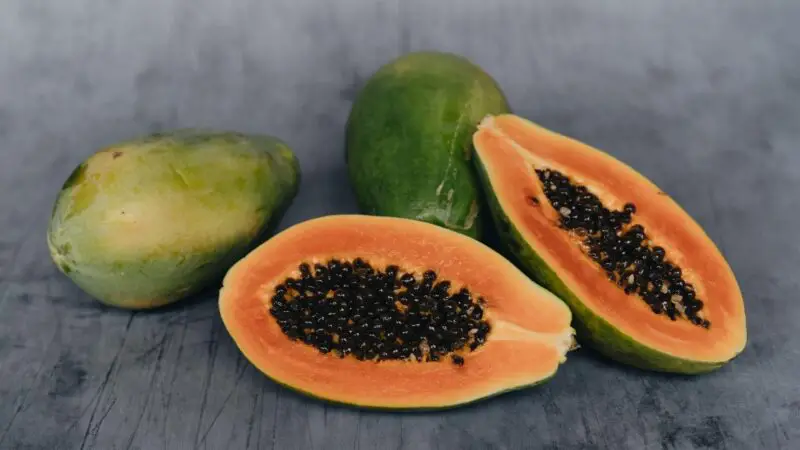
There are three possible risks with feeding papaya to your guinea pigs: urinary complications, problems with digestion and weight changes.
- Urinary complications – The calcium in the papaya can cause bladder and kidney stones for the guinea pig if fed in excess. Unless the guinea pig is very young and still growing, this is not a crucial mineral for them.
- Problems with digestion – The fiber and sugar in papaya could damage digestion if you feed the cavy too much papaya. Thus, excess sugar and fiber will cause tummy pains, gas, and loose stool with cramping.
- Weight changes – Papaya is rich in carbs and sugar, and these nutrients are the fattening ones here if you feed the guinea pig too much papaya.
Serving and Frequency of Papaya for Guinea Pigs
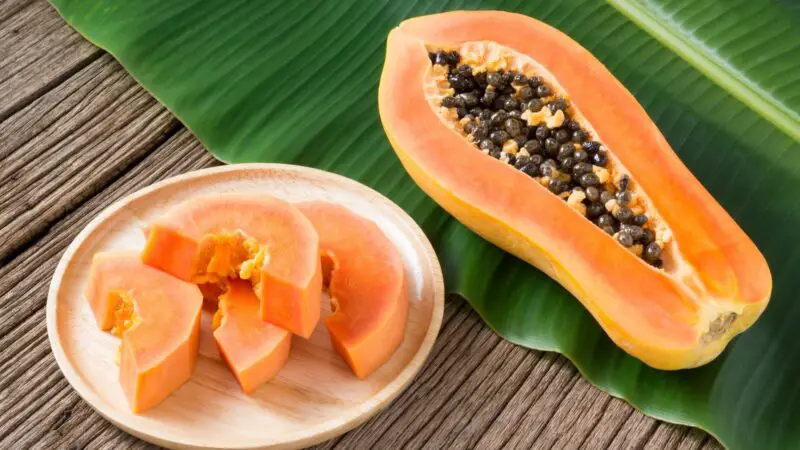
Remember, feed papaya to guinea pigs 2 times per week. A normal serving would be a small handful or a few slices/chunks. If you want, you can peel it first, but this is not mandatory. However, if unpeeled, wash it very well.
However, you must remove the seeds and slice the fruit so that it is easier to chew. Make sure to use ripe papaya because it is softer and tastier. Once you remove the seeds with a spoon, you can also spoon out the flesh with ease. If this is a new food for the cavy, feed him just one bite. And if it likes it, you can give the guinea pig a few more slices or chunks.
Quicks on Papaya
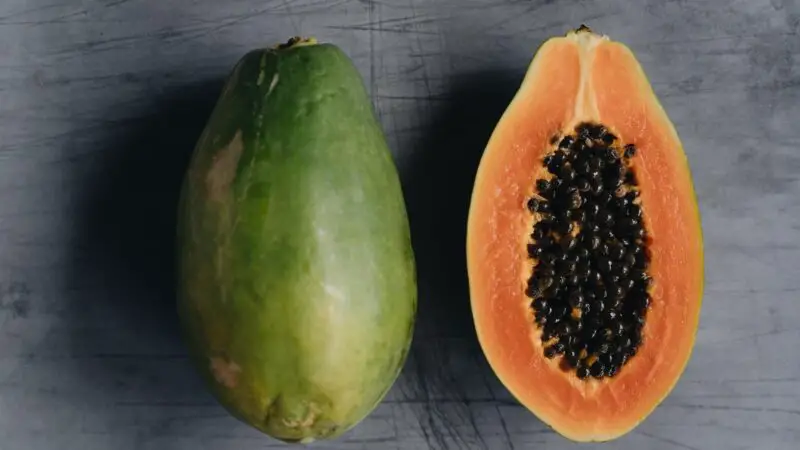
- It is believed that papaya originates from Central America and Mexico.
- There is a National Papaya Month – September
- There is a white powder named “Meat Tenderizer” and it contains the papaya enzyme, papain!
- You can find two kinds of papaya in markets: Mexican and Hawaiian.
- Another name for papaya is tree melon. In Australia, they call it Paw Paw or Papaw.
- In Asia, papaya leaves are eaten when steamed.
- Too much papaya can cause the same effect as too many carrots – the yellowish color of the skin on palms and feet.
- The seeds of papaya are edible too, in fact, they are used as black pepper!
- Unripe papaya has green skin, and the ripe one is orange-yellow.
- The Hawaiian papaya looks like a pear and weighs less, and the Mexican looks bulkier and weighs up to 10 lbs.
We have also made a full list of foods that guinea pigs can and can’t eat (150+ Types of Foods). Be sure to also check our recommended products page for everything you will ever need to assure a happy life for your guinea pigs. Hope this information was helpful and you have found the answer you were looking for.
List of Sources
A Care Guide for Your Guinea Pig (Cavia Porcellus)
How to Care For Your Pet Guinea Pig
The Effects of Diet on Anatomy, Physiology and Health in the Guinea Pig
